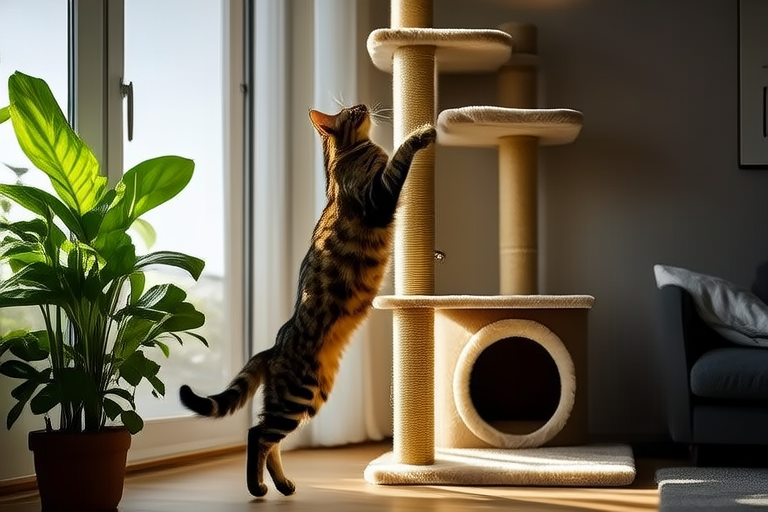Living with a Bengal Cat: Tips for Creating the Perfect Home Environment
Bengal cats are known for their striking appearance and playful personalities, making them a popular choice among cat lovers. However, these felines require a unique home environment that caters to their high energy levels and social needs. This comprehensive guide will provide you with insights into Bengal cat behavior, essential dietary needs, interactive play suggestions, suitable environmental enrichment, grooming tips, health considerations, and advice on integrating Bengals into multi-pet households.
Bengal Cat Behavior
Bengal cats are descendants of the Asian leopard cat, which explains their wild and energetic nature. They are highly intelligent, curious, and social animals that thrive in environments where they can explore and interact with their surroundings. Bengal cats love to climb, jump, and chase, and they enjoy being around people or other pets. Their behavior is often compared to that of dogs, as they are known to follow their owners around and participate in family activities.
Essential Dietary Needs
Providing your Bengal cat with a balanced diet is crucial for maintaining their health and energy levels. Bengals have a higher protein requirement than many other breeds, so it’s important to choose a high-quality food that contains at least 30% animal-based protein. Wet food is preferable because it provides more moisture, which can help prevent urinary tract issues. Additionally, Bengals are prone to obesity, so portion control and regular exercise are necessary to keep them healthy.
Interactive Play Suggestions
To keep your Bengal cat entertained and mentally stimulated, engage them in interactive play sessions. Use toys that encourage jumping, chasing, and pouncing, such as feather wands, laser pointers, and puzzle feeders. Rotate toys regularly to maintain your cat’s interest, and make sure to spend at least 15 minutes each day playing with your Bengal. This not only helps burn off excess energy but also strengthens the bond between you and your pet.
Suitable Environmental Enrichment
Creating a stimulating yet safe environment is essential for your Bengal cat’s well-being. Provide multiple levels of vertical space, such as cat trees, shelves, and window perches, to satisfy their climbing instincts. Bengal cats also enjoy water, so consider adding a fountain or a shallow dish filled with fresh water for them to splash in. Additionally, incorporate hiding spots and tunnels to give your cat places to retreat when they need some alone time.
Grooming Tips
Bengal cats have short, dense coats that require minimal grooming, but regular brushing can help prevent matting and reduce shedding. Use a soft-bristled brush or a grooming mitt to gently remove loose fur and distribute natural oils throughout their coat. Bengals also enjoy being petted and brushed, so this activity can be a great bonding experience. In addition, check their ears weekly for signs of wax buildup or infection, and clean them if necessary. Finally, trim their nails every few weeks to prevent scratching damage to furniture and carpets.
Health Considerations
Regular veterinary checkups are vital for maintaining your Bengal cat’s health. Bengals are generally healthy, but they can be prone to certain conditions, such as hypertrophic cardiomyopathy (HCM), a heart disease, and progressive retinal atrophy (PRA), an eye condition. Early detection and treatment can significantly improve their quality of life. Additionally, Bengals may be sensitive to anesthesia, so inform your veterinarian if your cat has a history of respiratory issues or heart problems. Lastly, ensure your cat is up-to-date on vaccinations and flea prevention.
Advice on Integrating Bengals into Multi-Pet Households
If you’re introducing a Bengal cat to a household with other pets, take things slowly and carefully. Bengals can be territorial and may not always get along with other cats or dogs. Start by keeping the new arrival in a separate room with its own litter box, food, and water. Gradually introduce the pets through a closed door, allowing them to become familiar with each other’s scent before meeting face-to-face. Supervise all interactions during initial meetings, and provide each pet with its own resources to avoid conflicts over territory or attention. With patience and proper introduction techniques, your Bengal can coexist peacefully with other pets.
Conclusion
Living with a Bengal cat is an enriching experience that requires dedication and understanding of their unique needs. By providing a stimulating environment, engaging in interactive play, and ensuring proper nutrition and healthcare, you can create a perfect home environment for your Bengal cat. Remember that each cat is an individual, so observe your pet’s behavior and adjust their care accordingly. With the right approach, you’ll enjoy a loving and rewarding relationship with your Bengal cat.
